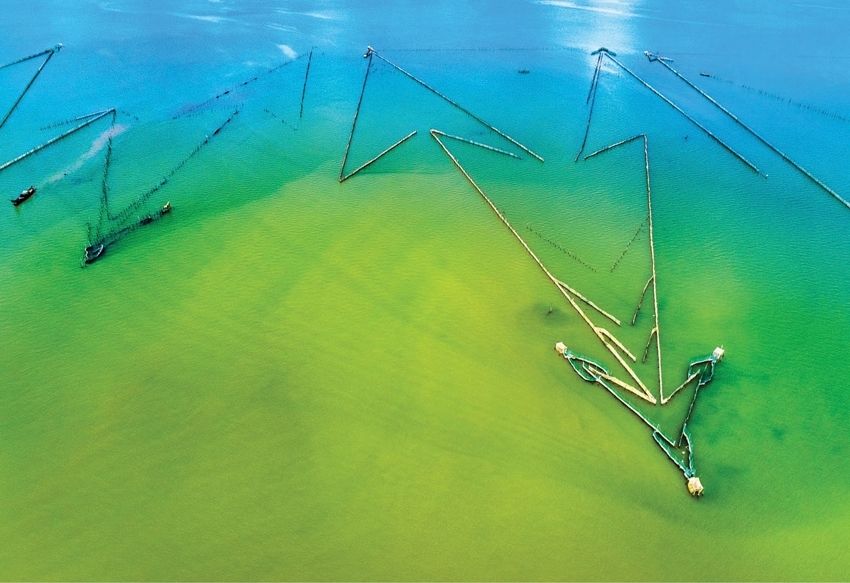Tam Giang - Cau Hai lagoon system is a world-class brackish water area. It is the largest in Southeast Asia, with special value in biological resources and countless gripping things in history and culture.... This area is seen as a "precious biological gem" that nature has bestowed on the ancient capital. With what existent, is it necessary to build an exhibition space or a museum for the Tam Giang - Cau Hai lagoon system?

Traditional seafood exploitation in Tam Giang - Cau Hai
This idea was proposed by researcher Nguyen Phuoc Bao Dan (National Sub-Institute of Culture and Arts Studies in Hue) at the workshop on the Tam Giang - Cau Hai lagoon. Although initially suggested, it has drawn great support from cultural and natural conservation experts.
On the Central Region strip of land and Hue in particular, the sea - lagoon - plain - hillock - Truong Son mountain system is what appears vividly from an east-west geographic perspective. This extremely short distance is a natural constant as mentioned by many researchers, but it is also the factor that creates cultural diversity if viewed from a specific sub-region perspective. Tam Giang - Cau Hai Lagoon, from this perspective, can be said to boast part of the cultural composition of Hue.
Tam Giang - Cau Hai lagoon area is a large brackish water lagoon chain of the province, with a total area of about 22,000 hectares, nearly 70km long running northwest-southeast (parallel to the coast). The first point is from the end of the O Lau River flowing downstream and gradually expanding through Phong Dien, Quang Dien districts, Hue City, Phu Vang, and Phu Loc District, forming Tam Giang Lagoon (from O Lau River to Thuan An Estuary); Thuy Tu Lagoon (including Chuon Lagoon, Sam Lagoon, Thuy Tu Lagoon) and Cau Hai Lagoon connecting with Tu Hien Estuary.
According to researcher Bao Dan, the lagoon area is home to many specific fish species and diverse aquatic algae species, and among them, there is always change and replacement according to the seasons, within a cycle with the increase or decrease in salinity and freshness of the water source. It is this diverse ecosystem that lays the foundation for a rich source of food and cuisine. The lagoon area is also the space for many unique dish systems bearing regional identities.
In addition, the water people who have existed for generations on this water surface have gathered for themselves and the community a lot of valuable experience in dealing with the specific brackish water ecological environment.
“The water people here have an understanding of the water, bottom surface, weather in the lagoon, or the aquatic resources through the seasonal calendar, fishing cycle, and distribution location of types of fishing tools and methods, ritual systems related to livelihoods, rituals, and customs in the human life cycle. This traditional culture has undergone change and replacement in certain historical periods for many reasons, and today, many different examples can be cited," researcher Bao Dan analyzed. Therefore, this time is the opportunity for us to preserve precious traditional culture in many different ways, the most effective of which is to build a water museum.
To this end, researcher Bao Dan said it is needed to identify a database focusing on human resources, material, spiritual and cultural resources, handicrafts resources, and folk arts resources... The in-depth database identification will provide the foundation for a rich and lively museum. Resting on the initial conditions and goals set, it is possible to build an exhibition house about the Tam Giang - Cau Hai Lagoon, and then the Tam Giang - Cau Hai Lagoon Museum when the basic conditions are firm.
Building a gallery or museum, according to the researcher at the National Sub-Institute of Culture and Arts Studies in Hue, still rests on many different conditions. In particular, the issues of human resources and funding pose huge challenges.
However, if setting to, we still have underlying advantages. It can be mentioned such as timing and topicality because this time is quite suitable when the water people have settled down, but many sections remain closely associated with traditional livelihoods. Also, there is the rich traditional culture of the community and the convenient transportation network to the area both by water and land…
Story: Nhat Minh - Photo: Tuan Kiet